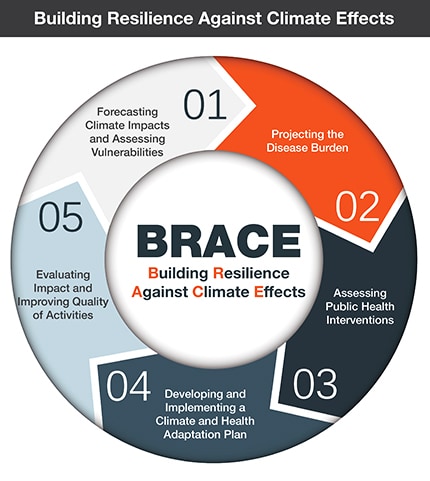CDC Environmental Health Nexus Newsletter
Healthy Environment, Healthy You
Environmental health affects everyone. Each issue of this free newsletter provides information about environmental health that is current, relevant, and actionable, and what CDC is doing to help. You will get information about upcoming webinars, environmental threats to health, and steps people can take to protect themselves and their families.
Sign up for the EH Nexus newsletter.
Looking for previous EH Nexus newsletters? Find the archive here.
The first CDC Environmental Health Nexus Newsletter focuses on CDC’s Climate and Health initiatives, environmental updates, and resources; it also promotes the upcoming EH Nexus webinar. Sign up for the EH Nexus newsletter to get the full story and get all the updates.
April 7, 2021 | Volume 1

Get to Know the Environmental Health Nexus
Welcome to the first edition of CDC’s Division of Environmental Health Science and Practice (DEHSP) Environmental Health Nexus (EH Nexus) newsletter.
Environmental health affects everyone. The air we breathe, the food we eat, the water we drink, and other aspects of the environment in which we live, work, and play all have a direct impact on our health. This includes chronic diseases such as asthma. Our environment also plays a crucial role in preventing or mitigating the spread of infectious diseases.
These monthly newsletters provide information about environmental health that is current, relevant, and actionable. It is written for interested members of the public, community advocates, and our colleagues working in environmental and public health.
By sharing timely information about environmental health concerns and the steps people and communities can take to protect themselves, we hope to raise awareness, encourage positive steps nationally and globally, and help advance humanity’s progress toward environmental justice and health equity.
To subscribe, please click here, enter your email address, and click the subscribe button.
Environmental Health Nexus Webinar on April 14 at 1 p.m. ET
Climate change directly affects your health and the health of your community, but there are steps communities can take to protect themselves.
Please join the inaugural webinar for CDC’s Environmental Health Nexus to learn how climate affects health and how communities can prepare. This special webinar will be broadcast on CDC’s Facebook page https://www.facebook.com/CDC on April 14 at 1 p.m. ET. Closed captioning will be available through Streamtext.
Impacts of Climate on Human Health
When elements of our environment are compromised, our risk of experiencing negative health outcomes increases significantly. Climate change, combined with other natural and human-made health stressors, influences human health and disease in numerous ways. Climate change affects all people, however, health outcomes impact certain populations more, including children, older adults, people living in poverty, those with underlying health conditions, and those living in certain higher risk geographic areas.
Every community has different levels of risk from environmental health hazards and exposures, which is why we focus on environmental justice and health equity. CDC’s Climate and Health Program helps states, cities, territories, and tribes protect human health from a changing climate. CDC provides data, tools, and technical guidance to help U.S. health agencies reduce vulnerability and increase resilience to the health effects of climate change.
Steps Communities Can Take
CDC’s Climate-Ready States and Cities Initiative (CRSCI) is working with internal and external partners to implement the Building Resilience Against Climate Effects (BRACE) framework, a five-step process that empowers health officials to prepare for and respond to the health effects of climate change.
The BRACE Framework Includes These Five Sequential Steps:

Step 1 – Anticipate Climate Impacts and Assess Vulnerabilities: Identify the scope of climate impacts, associated potential health outcomes, and populations and locations vulnerable to these health impacts.
Step 2 – Project the Disease Burden: Estimate or quantify the additional burden of health outcomes associated with climate change.
Step 3 – Assess Public Health Interventions: Identify the most suitable health interventions for the identified health impacts of greatest concern.
Step 4 – Develop and Implement a Climate and Health Adaptation Plan: Develop a written adaptation plan that is regularly updated. Disseminate and oversee implementation of the plan.
Step 5 – Evaluate Impact and Improve Quality of Activities: Evaluate the process. Determine the value of information attained and activities undertaken.
BRACE Communication Resources
- To learn more, read about CDC’s BRACE Framework.
- Watch this animated video describing the BRACE framework.
- Check Out Environmental Justice Data on CDC’s Tracking Network
CDC’s Environmental Public Health Tracking Network is an online information and visualization platform that brings together health and environmental data from national, state and local partners. Tracking Network data and information can be used to make decisions about our environment and our health, including personal, community, regulatory, and public health decisions. Check out one of the newest content areas, Environmental Justice, and learn more about demographic factors, environmental burdens, socioeconomic conditions, and public health concerns directly related to environmental justice.
- Learn More About Communicating Effectively to Overcome Misinformation
DEHSP staff members Anna Khan, Tabitha Dove, and Sarah Segerlind recently authored an article in the Journal of Environmental Health about using communication techniques to counter misinformation pdf icon[PDF – 909 KB]external icon. It is set in the context of the expanded use of cleaners and disinfectants during January–March 2020. This article provides relevant insight to anyone who communicates about environmental health.
- Watch CDC’s Climate Change and Your Health Video
Climate change can affect human health in many ways, including impacts from wildfires, flooding, and extreme heat. CDC’s Climate and Health Program supports state, tribal, local, and territorial public health agencies as they prepare for specific health impacts of a changing climate. Join us for a virtual tour of our museum exhibit describing these health impacts and how we are helping our communities address them.
Thank you for reading and for helping to keep our environments healthy.
If you are not yet a subscriber, please click here, enter your email address, and click the subscribe button at the bottom of the webpage.